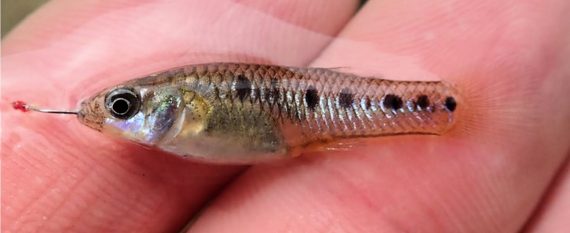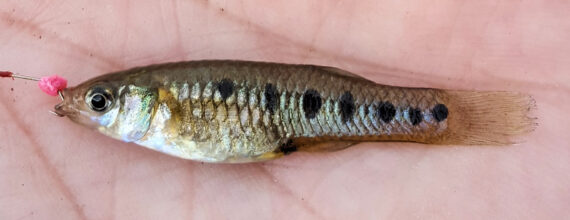Porthole Livebearer, Poeciliopsis gracilis
 Porthole Livebearer, Poeciliopsis gracilis. Fish caught out of an irrigation ditch adjacent to the Salton Sea, southeastern California, March 2018. Length: 3.6 cm (1.4 inches). Catch, photograph and identification courtesy of Ben Cantrell, San Diego, California.
Porthole Livebearer, Poeciliopsis gracilis. Fish caught out of an irrigation ditch adjacent to the Salton Sea, southeastern California, March 2018. Length: 3.6 cm (1.4 inches). Catch, photograph and identification courtesy of Ben Cantrell, San Diego, California.
 Porthole Livebearer, Poeciliopsis gracilis. Fish caught out of an irrigation ditch adjacent to the Salton Sea, southeastern California, March 2018. Length: 3.8 cm (1.5 inches). Catch, photograph and identification courtesy of Chris Moore, Peoria, Arizona.
Porthole Livebearer, Poeciliopsis gracilis. Fish caught out of an irrigation ditch adjacent to the Salton Sea, southeastern California, March 2018. Length: 3.8 cm (1.5 inches). Catch, photograph and identification courtesy of Chris Moore, Peoria, Arizona.
The Porthole Livebearer, Poeciliopsis gracilis, is a member of the Livebearer or Poeciliidae Family, and is known in Mexico as guatopote jarocho. Their common name stems from the round black markings on their sides that resemble the portholes of a ship. Globally, there are twenty-four species in the genus Poeciliopsis, of which nineteen are found in Mexican freshwater systems that feed into the Atlantic and/or the Pacific Oceans.
The Porthole Livebearer has a small short body with a large abdomen. The head is large and flattened with a small upturned protrusible mouth and large eyes. They are not overly colorful with both the males and females having a silvery-gold base with an iridescent blue overlaid with 3 to 8 dark round spots along the sides. The Porthole Livebearer is sexually dimorphic with females being larger than males with a maximum length of 6.4 cm (2.5 inches) versus 3.8 cm (1.5 inches). The males are also much smaller and slimmer than the females and have a pointed anal fin, versus rounded in the females. Their caudal is rounded and their dorsal fin is short and set behind the base of the anal fin.
The Porthole Livebearer is a non-migratory freshwater species that is found in ditches, irrigation canals, lakes, ponds, reservoirs and streams that can be clear, turbid or very muddy. They prefer water temperatures between 24oC (75oF) and 28oC (83oF). They are voracious surface feeders that consume detritus, small insects and insect larvae, and zooplankton near the surface with mosquito larvae being only a small component of their diet. They practice cannibalism when ample food is not available. They have a high feeding capacity and are capable of consuming 42% to 167% of their body weight on a daily basis. In turn they are heavily preyed upon by shore birds including Herons. Reproduction is viviparous and involves internal fertilization, a 30-day gestation period, with each female giving birth to 10 to 50 live young. They reach sexual maturity within three months of birth. The Porthole Livebearer is poorly studied with very limited information available about their lifestyle and behavioral patterns including specific details on age, growth, longevity, movement patterns, diet, habitat use, and reproduction.
The Porthole Livebearer is found within all Mexican freshwater systems that drain into both the Atlantic and the Pacific Oceans. For the Atlantic they are found within the Coatzacoalcos River in the States of Oaxaca and Veracruz south to Belize. For the Pacific they are found from Río Verde, Oaxaca south to the Guatemala border. They have also recently been introduced to the rivers in the states of Guerrero, Michoacán, Morelos, Quintana Roo and San Luis Potosí that drain into both the Atlantic and Pacific Oceans.
The Porthole Livebearer is very similar in appearance and in body structure to several other poecilids but they are the only poecilid that has 4 to 8 black spots along their sides.
From a conservation perspective the Porthole Livebearer is currently considered to be of Least Concern with stable, widely distributed populations. They are utilized extensively by the aquarium trade as they are very easy to maintain, prolific breeders in captivity and active swimmers. Their long-term viability within their native range is of concern due to habitat loss and degradation.